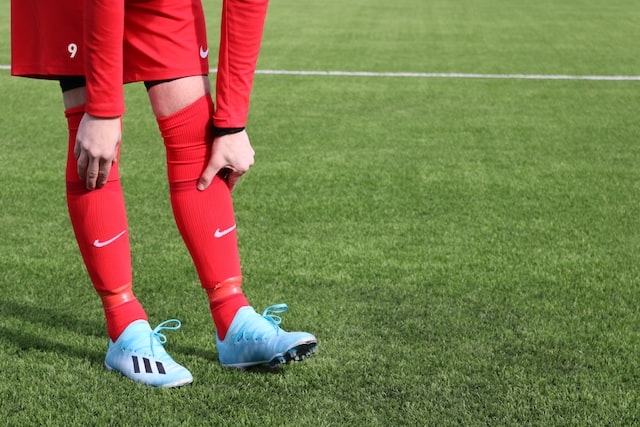*Our published content contains affiliate links that may lead to a small commission. Full disclosure here.
We love hearing from members of the Soccer Knowledge Hub community, and we always welcome inquiries. We also love it when you guys ask us questions, and we try and answer as many of them as we can.
Therefore, we’ve decided to answer five questions that we’ve heard a lot recently in the same article. They’re all related to soccer kit (hence the title), but we didn’t think they warranted an entire article to themselves.
So, dive in below to find out the answers to some of the most pressing questions relating to soccer kit from the SKH community!
Why do soccer players cut their socks?
Soccer players cut their socks to reduce the pressure on their calf muscles. Many of the socks that soccer players wear are particularly tight-fitting, which means the blood flow is somewhat restricted underneath the socks.
Cutting holes in the socks relieves some of the tension that players feel when their socks are tied, which is a simple enough solution to the problem!
Lots of players do this – Kyle Walker is often seen playing with holes in his socks, and it’s very much part and parcel of the modern game.
An alternative to cutting your socks is wearing them lower around your calves, like Jack Grealish. Ultimately, you should do whatever’s comfortable for you, and if that means cutting holes in your long socks, then so be it!
What are soccer balls filled with?
Soccer balls are filled with regular air, so a combination of nitrogen and oxygen. Some people wrongly assume that soccer balls are filled with helium, but this is not the case.
You inflate a soccer ball with a needle and an air pump, and there’s no specialist equipment other than that required to get your soccer ball to the right temperature.
So, the simple answer to this question is that soccer balls are filled with air!
Why do soccer players wear long socks?
Soccer players wear long socks to enable them to wear shin guards. As part of their equipment, soccer players are required to wear shin guards to protect their shins, and long socks enable them to wear shin guards without any issues.
While some players wear slip-on shin guards, others wear them with ankle guards. Either way, long socks keep players’ shin guards in place and offer additional protection against robust challenges that they might experience on the soccer field.
Another reason why soccer players wear long socks is that they have been an integral part of the soccer kit for a long time now. The first kits in the nineteenth century (before shin guards) had long socks as standard, so it’s a tradition of the game.
Some players opt to wear their socks lower down their legs during matches, but they are still wearing long socks – they’ve just rolled them down. So, whether we like it or not, long socks have been a part of soccer for a long time, and it’s not likely to change in the future!
What do soccer players wear under their shorts?
Most soccer players wear lightweight, moisture-wicking undershorts underneath their shorts. Not only are they comfortable, but they prevent moisture from building up around your private areas and stop rashes from forming.
While you can wear anything (within reason) underneath your shorts on a soccer field, buying a pair of soccer undershorts is undoubtedly worth it. If you play in cold weather, you could also pair your shorts with an undervest if you wish.
We suspect that some soccer players even go commando, but we have no way of backing up this claim! So, to be on the safe side, we’d recommend wearing a pair of specialist undershorts when you next take to the field.
Why do soccer players wear a bra?
Some soccer players wear GPS bras underneath their shirts. The so-called bras are made from neoprene and contain a GPS chip that monitors the player’s movement throughout a game. The coaching team then uses the data to analyze the player’s performance and contribution to the game.
The GPS chip records multiple crucial metrics, including heart rate and the number of calories a player has burned during a training session or match.
While some players wear these bras during matches, others wear them exclusively during training. Either way, they provide the coaching team with key data relating to that individual’s performance levels, which can affect team selection in the coming weeks.
Recap: Five soccer kit FAQs answered
So, there you have it – five common kit FAQs answered. As mentioned, we decided on this format to offer you some quick answers to your most pressing questions, but if you would like us to elaborate on any of the answers that we’ve given, drop a comment below and let us know!

